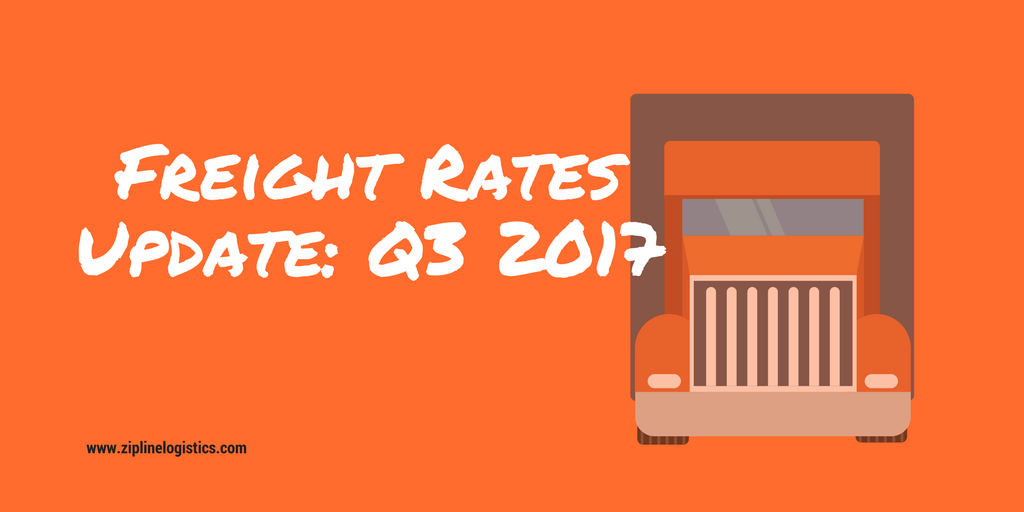
The freight market may finally be rebounding from its multi-year slump.
Mark Montague, an industry rate analyst for DAT Solutions, states that “The robust supply of van and refrigerated truckload freight in May and June, combined with higher spot market rates and load-to-truck ratios, are signs that the freight recession is over.”
The July 4th holiday might have been a catalyst, with post-holiday van volumes in the top 100 lanes hitting record levels. However, higher demand has not led to an equal push for a long-term rate bump.
At Zipline Logistics, we felt capacity tighten and spot rates inflate in June and July, significantly more than we did last year. Yet, while overall capacity may remain tighter than in previous months, supply remains plentiful in most regions as the seasonal swing eases.
As we wait to see if this shift is temporary or if it will continue into the second half of 2017 and possibly 2018, here are a few things to keep in mind:
2017 Freight Market
It’s not an exact science, but historically transportation costs go down as produce season ends. This year, the transition back from produce season pricing has been delayed and rates remain heightened on many lanes. We feel this is a result of carriers working to hang-on to higher prices for longer than they have in previous years.
This fact and its impact can be seen by looking at the spot market. According to DAT, all tracked truckload spot market segments saw gains in June. It was a booming month for activity and the bustle has continued into July.
On a related note, for shippers who are protected with contract rates, know that logistics partners are experiencing tighter margins as the market shifts, potentially even losses on some lanes. You shouldn’t experience any direct impacts, but plan for your next bid and talk candidly with your 3PL partners about expectations.
This situation – spot market rates climbing above contract rates – creates a perfect storm of service issues and tender declines.
Trucking Service Level Impacts
Be wary that in a tighter marketplace some carriers may choose to decline orders or demand different terms to maximize their own capacity and hours of service. In the June 2017 Morgan Stanley Truckload Sentiment Survey, a carrier respondent says, “…We’re able to be selective about what freight we take and what we leave for other carriers to run.”
If unwilling to pay slightly higher prices or make schedule changes, some shippers may be left with few options or end up with poor performance. To remain competitive, shippers should strive to become a “shipper of choice.” This includes providing ample lead time on orders, running facilities so they have minimal dwell time, and being flexible with appointment scheduling.
Learn More About Becoming a Shipper of Choice
Equally important is working with a partner that keeps its promises and stays committed to difficult shipments. Service issues will undoubtedly arise during a market shift. But if your 3PL continuously drops the ball, doesn’t offer new solutions, or cancels appointments or trucks, consider working with someone else.
Retail Logistics and Peak Season
Q3 and Q4 are traditionally “peak season” for the retail industry and retail-serving transportation providers. Retailers begin preparing for the holiday and back-to-school rushes, ordering, importing, and shipping larger volumes. To adjust for added demand, many carriers will implement peak season surcharges.
As demand rises and capacity is constrained, factoring in enough lead time for order optimization and buffer time for potential disruptions or delays is essential.
Additionally, shippers may want to consider using rail for longer shipments. With a heads-up that truck rates are on the rise, intermodal could be a cost-effective solution. Talk to your logistics partner(s) to determine if this solution is available to you.
Maritime Changes
Q1 and Q2 brought many changes for the maritime market. Mergers of ship lines and new vessel sharing agreements are all impacting capacity, in a multitude of ways.
For example, a Zipline client that previously shipped product directly from Singapore to the U.S. must now use transshipment strategies. Ships are no longer traveling partially full, and are instead getting smarter with maximizing capacity. Through alliances, ship lines can move product between vessels and ports to be more efficient with space. This offers more options to shippers, but often also means longer transit times. Additionally, going in and out of multiple ports means that transshipments have potential to cause schedule or service errors.
Furthermore, mergers mean more price control for ocean carriers. For the same customer, shipping from Singapore previously entailed quoting 2-3 different ship lines. Now there is just one service provider who handles that lane. The customer has less control over pricing and must meet the requirements set by the carrier. Thankfully we haven’t seen monopolized pricing and ocean carriers are still highly competitive, offering improved service and options through alliances.
ELD Mandate
A bill was filed in the U.S. House to try and delay the compliance date of the electronic logging device (ELD) mandate by two years, to December 2019.
Some sources have predicted that ELD compliance will have an impact on capacity, tightening availability as smaller fleets and owner-operators work to get accustomed and make necessary investments. Others predict that ELDs will have a very minimal influence on carrier availability. If the new bill passes, more time to update fleets will mean even less of a potential impact.
The long-predicted rise in trucking rates might officially be here, but it’s still too soon to tell for sure. But, at Zipline Logistics we’re working with that expectation in mind. That means talking to carriers now, and not waiting until capacity gets overly tight.